NF-kappaB1 (p50) is upregulated in lipopolysaccharide tolerance and can block tumor necrosis factor gene expression
- PMID: 10084986
- PMCID: PMC96496
- DOI: 10.1128/IAI.67.4.1553-1559.1999
NF-kappaB1 (p50) is upregulated in lipopolysaccharide tolerance and can block tumor necrosis factor gene expression
Abstract
Monocytes respond to lipopolysaccharide (LPS) stimulation with a rapid expression of the tumor necrosis factor (TNF) gene. Upon repeated LPS stimulation there is, however, little production of TNF mRNA and protein; i.e., the cells are tolerant to LPS. Analysis of NF-kappaB proteins in gel shift assays demonstrated that the DNA binding activity that is induced by LPS stimulation in tolerant cells consists mainly of p50-p50 homodimers. Since p50 can bind to DNA but lacks a transactivation domain, this may explain the blockade of TNF gene expression. We now show that in the monocytic cell line Mono Mac 6, this inability to respond can be largely ascribed to NF-kappaB, since a reporter construct directed by a trimeric NF-kappaB motif is strongly transactivated by LPS stimulation of naive cells whereas LPS-tolerant cells exhibit only low activity. Also, Western blot analyses of proteins extracted from purified nuclei showed mobilization of threefold-higher levels of p50 protein in tolerant compared to naive cells, while mobilization of p65 was unaltered. Overexpression of p50 in HEK 293 cells resulted in a strong reduction of p65-driven TNF promoter activity at the levels of both luciferase mRNA and protein. These data support the concept that an upregulation of p50 is instrumental in LPS tolerance in human monocytes.
Figures

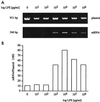
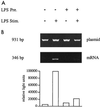

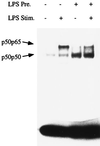
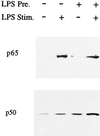
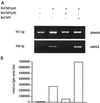
Similar articles
-
Role of p52 (NF-kappaB2) in LPS tolerance in a human B cell line.Biol Chem. 1999 Oct;380(10):1193-9. doi: 10.1515/BC.1999.151. Biol Chem. 1999. PMID: 10595582
-
Tolerance to lipopolysaccharide involves mobilization of nuclear factor kappa B with predominance of p50 homodimers.J Biol Chem. 1994 Jun 24;269(25):17001-4. J Biol Chem. 1994. PMID: 7516328
-
TNF-alpha gene expression in macrophages: regulation by NF-kappa B is independent of c-Jun or C/EBP beta.J Immunol. 2000 Apr 15;164(8):4277-85. doi: 10.4049/jimmunol.164.8.4277. J Immunol. 2000. PMID: 10754326
-
LPS tolerance in monocytes/macrophages: three 3' cytosins are required in the DNA binding motif for detection of upregulated NF-kappa B p50 homodimers.Immunobiology. 1997 Dec;198(1-3):81-90. doi: 10.1016/s0171-2985(97)80029-0. Immunobiology. 1997. PMID: 9442380
-
Thymoquinone attenuates proinflammatory responses in lipopolysaccharide-activated mast cells by modulating NF-kappaB nuclear transactivation.Biochim Biophys Acta. 2007 Apr;1770(4):556-64. doi: 10.1016/j.bbagen.2007.01.002. Epub 2007 Jan 12. Biochim Biophys Acta. 2007. PMID: 17292554
Cited by
-
Lipopolysaccharide-induced inhibition of transcription of tlr4 in vitro is reversed by dexamethasone and correlates with presence of conserved NFκB binding sites.Biochem Biophys Res Commun. 2013 Mar 8;432(2):256-61. doi: 10.1016/j.bbrc.2013.02.002. Epub 2013 Feb 10. Biochem Biophys Res Commun. 2013. PMID: 23402753 Free PMC article.
-
Molecular control of steady-state dendritic cell maturation and immune homeostasis.Annu Rev Immunol. 2013;31:743-91. doi: 10.1146/annurev-immunol-020711-074929. Epub 2013 Jan 17. Annu Rev Immunol. 2013. PMID: 23330953 Free PMC article. Review.
-
Induction of endotoxin tolerance in vivo inhibits activation of IRAK4 and increases negative regulators IRAK-M, SHIP-1, and A20.J Leukoc Biol. 2011 Dec;90(6):1141-8. doi: 10.1189/jlb.0611273. Epub 2011 Sep 20. J Leukoc Biol. 2011. PMID: 21934070 Free PMC article.
-
Mechanisms of intestinal inflammation and development of associated cancers: lessons learned from mouse models.Mutat Res. 2010 Jul-Sep;705(1):40-59. doi: 10.1016/j.mrrev.2010.03.001. Epub 2010 Mar 16. Mutat Res. 2010. PMID: 20298806 Free PMC article. Review.
-
The nuclear factor NF-kappaB pathway in inflammation.Cold Spring Harb Perspect Biol. 2009 Dec;1(6):a001651. doi: 10.1101/cshperspect.a001651. Epub 2009 Oct 7. Cold Spring Harb Perspect Biol. 2009. PMID: 20457564 Free PMC article. Review.
References
-
- Blackwell T S, Blackwell T R, Christman J W. Induction of endotoxin tolerance depletes nuclear factor-κB and suppresses its activation in rat alveolar macrophages. J Leukoc Biol. 1997;62:885–891. - PubMed
-
- Coffee K A, Halushka P V, Ashton S H, Tempel G E, Wise W C, Cook J A. Endotoxin tolerance is associated with altered GTP-binding protein function. J Appl Physiol. 1992;73:1008–1013. - PubMed
-
- Durando M, Ashton S H, Makhlouf M A, Simmons-Wagner R, Halushka P V, Cook J A. Endotoxin-induced desensitization of THP-1 cells is not associated with altered G protein binding or content. J Endotoxin Res. 1997;4:97–103.
-
- Ertel W, Kremer J-P, Kenney J, Steckholzer U, Jarrar D, Trentz O, Schildberg F W. Downregulation of proinflammatory cytokine release in whole blood from septic patients. Blood. 1995;85:1341–1347. - PubMed
Publication types
MeSH terms
Substances
LinkOut - more resources
Full Text Sources
Research Materials
Miscellaneous

